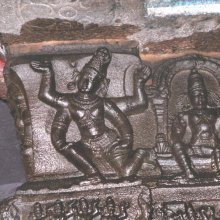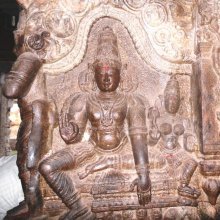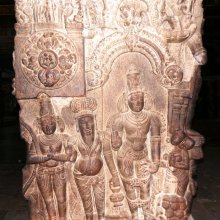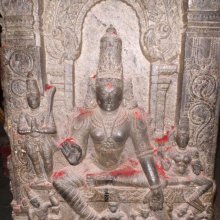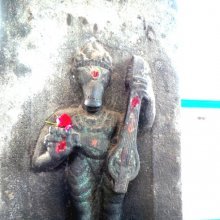Jnanamudra, Jñānamudrā, Jnana-mudra, Jñānamudra: 13 definitions
Introduction:
Jnanamudra means something in Hinduism, Sanskrit. If you want to know the exact meaning, history, etymology or English translation of this term then check out the descriptions on this page. Add your comment or reference to a book if you want to contribute to this summary article.
Images (photo gallery)
In Hinduism
Yoga (school of philosophy)
Source: Typepad: Mudras for PranayamaJnana Mudra (psychic gesture of knowledge) In Jnana mudra the hands are placed on the knees in seated meditation with the palms facing up. This mudra gives a feeling of spaciousness and has a subtle uplifting effect on the body and mind. In both Chin and Jnana mudra the connection made by the thumb and index figure is said to create a kind of circuit by connecting the terminus of certain nadi thus re-circulating the body’s vital energy.

Yoga is originally considered a branch of Hindu philosophy (astika), but both ancient and modern Yoga combine the physical, mental and spiritual. Yoga teaches various physical techniques also known as āsanas (postures), used for various purposes (eg., meditation, contemplation, relaxation).
Shilpashastra (iconography)
Source: Google Books: The Book of Hindu Imagery: Gods, Manifestations and Their MeaningJnana(-mudra)—The hand is placed level with the heart with the palm facing upwards. The thumb forms a ring, usually with the ring finger. This is the gesture of wisdom, as a quality of the god concerned.
Source: Google Books: Elements of Hindu iconographyIn the Jñānamudrā (ज्ञानमुद्रा), the tips of the middle finger and of the thumb are joined together and held near the heart, with the palm of the hand turned towards the heart.

Shilpashastra (शिल्पशास्त्र, śilpaśāstra) represents the ancient Indian science (shastra) of creative arts (shilpa) such as sculpture, iconography and painting. Closely related to Vastushastra (architecture), they often share the same literature.
Purana and Itihasa (epic history)
Source: archive.org: Shiva Purana - English TranslationJñānamudrā (ज्ञानमुद्रा) is the name of a gesture (mudrā) mentioned in the Śivapurāṇa 1.20, while explaining the mode of worshipping an earthen phallic image (pārthiva-liṅga) according to the Vedic rites:—“[...] he shall show the “Śiva-mudrā” with the mantra ‘Eṣa te’; the Abhayamudrā with the mantra ‘Yato Yataḥ’ etc. and the Jñāna-mudrā with the Tryambaka-mantra”.

The Purana (पुराण, purāṇas) refers to Sanskrit literature preserving ancient India’s vast cultural history, including historical legends, religious ceremonies, various arts and sciences. The eighteen mahapuranas total over 400,000 shlokas (metrical couplets) and date to at least several centuries BCE.
Shaktism (Shakta philosophy)
Source: Google Books: ManthanabhairavatantramJñānamudrā (ज्ञानमुद्रा) refers to the “gesture of knowledge”, according to the Kularatnoddyota, one of the earliest Kubjikā Tantras.—Accordingly, “[...] (The gross form has) five faces, ten arms and, pure, it has a smiling face. [...] She makes boon bestowing and fear dispelling gestures and (holds) a rosary, book, noose, goad, large bow, and five arrows in her hands. She makes the gesture of knowledge [i.e., jñānamudrā] and holds a large vessel filled with wine. O great goddess! Delighted with supreme bliss, she causes the entire universe to melt. (This is how) you should be visualized in the Transmission of the Youth. [...]”.

Shakta (शाक्त, śākta) or Shaktism (śāktism) represents a tradition of Hinduism where the Goddess (Devi) is revered and worshipped. Shakta literature includes a range of scriptures, including various Agamas and Tantras, although its roots may be traced back to the Vedas.
Languages of India and abroad
Sanskrit dictionary
Source: DDSA: The practical Sanskrit-English dictionaryJñānamudra (ज्ञानमुद्र).—a. 'having the impress of wisdom', wise.
Jñānamudra is a Sanskrit compound consisting of the terms jñāna and mudra (मुद्र).
Source: Cologne Digital Sanskrit Dictionaries: Edgerton Buddhist Hybrid Sanskrit DictionaryJñānamudrā (ज्ञानमुद्रा).—(1) name of a samādhi: Saddharmapuṇḍarīka 424.3; (2) in Mahāvyutpatti 4298—4313 is a list of cpds. all ending -jñānamudrā, described in 4297 as dhāraṇī-mudrā; they are not listed individually here.
Source: Cologne Digital Sanskrit Dictionaries: Shabda-Sagara Sanskrit-English DictionaryJñānamudra (ज्ञानमुद्र).—mfn.
(-draḥ-drā-draṃ) Having the impress of wisdom, wise, making wise. E. jñāna, and mudrā a seal.
Source: Cologne Digital Sanskrit Dictionaries: Aufrecht Catalogus CatalogorumJñānamudrā (ज्ञानमुद्रा) as mentioned in Aufrecht’s Catalogus Catalogorum:—vedānta. Oppert. 5739.
Source: Cologne Digital Sanskrit Dictionaries: Monier-Williams Sanskrit-English Dictionary1) Jñānamudra (ज्ञानमुद्र):—[=jñāna-mudra] [from jñāna > jñā] mfn. having the impress of wisdom, wise, [Horace H. Wilson]
2) Jñānamudrā (ज्ञानमुद्रा):—[=jñāna-mudrā] [from jñāna-mudra > jñāna > jñā] f. a kind of Mudrā, [Hemādri’s Caturvarga-cintāmaṇi ii, 1, 765; Vratar.] ([Agastya-saṃhitā])
Source: Cologne Digital Sanskrit Dictionaries: Yates Sanskrit-English DictionaryJñānamudra (ज्ञानमुद्र):—[jñāna-mudra] (draḥ-drā-draṃ) a. Having the impress of wisdom, wise; making wise, imparting wisdom.
[Sanskrit to German]
Sanskrit, also spelled संस्कृतम् (saṃskṛtam), is an ancient language of India commonly seen as the grandmother of the Indo-European language family (even English!). Closely allied with Prakrit and Pali, Sanskrit is more exhaustive in both grammar and terms and has the most extensive collection of literature in the world, greatly surpassing its sister-languages Greek and Latin.
See also (Relevant definitions)
Partial matches: Jnana, Mudra.
Starts with: Jnanamudraparinaya.
Ends with: Abhijnanamudra, Duryodhanaviryajnanamudra, Mahacakrapraveshajnanamudra, Mahaprabhamandalavyuhajnanamudra, Mahatushtijnanamudra, Sarvadharmasamatajnanamudra, Sarvamaramandalavidhvamsanajnanamudra, Sarvatathagatabandhanajnanamudra, Sarvatathagatanuraganajnanamudra, Sarvatathagataprajnajnanamudra, Sarvatathagatasamajadhishthanajnanamudra, Sarvatathagatashaparipuranajnanamudra, Sarvatathagatavajrabhishekajnanamudra, Sarvatathagatavishvakarmajnanamudra.
Full-text (+4): Mahatushtijnanamudra, Sarvamaramandalavidhvamsanajnanamudra, Sarvadharmasamatajnanamudra, Mahacakrapraveshajnanamudra, Mahaprabhamandalavyuhajnanamudra, Sarvatathagatanuraganajnanamudra, Sarvatathagatasamajadhishthanajnanamudra, Sarvatathagatashaparipuranajnanamudra, Sarvatathagatavishvakarmajnanamudra, Sarvatathagataprajnajnanamudra, Sarvatathagatabandhanajnanamudra, Sarvatathagatavajrabhishekajnanamudra, Duryodhanaviryajnanamudra, Abhayamudra, Shivamudra, Jnanamaya, Shishya-bhava-murti, Pancamudra, Samasuci, Yogasana.
Relevant text
Search found 14 books and stories containing Jnanamudra, Jnana-mudra, Jñāna-mudrā, Jñāna-mudra, Jñānamudrā, Jñānamudra; (plurals include: Jnanamudras, mudras, mudrās, Jñānamudrās, Jñānamudras). You can also click to the full overview containing English textual excerpts. Below are direct links for the most relevant articles:
Sripura (Archaeological Survey) (by Bikash Chandra Pradhan)
Stone Images (5): Sakta Images < [Chapter 3 - Sculptural Programme]
Bhakti-rasamrta-sindhu (by Śrīla Rūpa Gosvāmī)
Verse 3.1.24 < [Part 1 - Neutral Love of God (śānta-rasa)]
Verse 3.1.26 < [Part 1 - Neutral Love of God (śānta-rasa)]
Lakulisha-Pashupata (Philosophy and Practice) (by Geetika Kaw Kher)
Vyakhyana Daksinamurti < [Chapter 3 - The Ritualistic Context]
Shat-cakra-nirupana (the six bodily centres) (by Arthur Avalon)
Verse 30 < [Section 5]
The Religion and Philosophy of Tevaram (Thevaram) (by M. A. Dorai Rangaswamy)
Chapter 4.3 - (c) Sculptures of Shiva and Dance < [Volume 2 - Nampi Arurar and Mythology]
Chapter 4.2 - Dakshinamurti < [Volume 2 - Nampi Arurar and Mythology]
